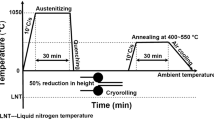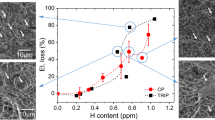Abstract
During the last few decades, keen attention has been paid to the advanced steels with the ultra-fine-grained (UFG) microstructure manufactured by severe plastic deformation (SPD) techniques. Although these materials often demonstrate prominent mechanical properties, the detrimental environmentally induced effects, such as hydrogen embrittlement (HE), which may appear during their service life, have been just scarcely studied. In particular, the influence of the hydrogen concentration and strain rate, which are among the main factors controlling HE, in general, has not been considered in UFG ferritic steels as yet. Thus, the objective of the present study was to examine the effect of these factors on the mechanical behaviour and fracture mode of the low-alloy steel processed by ECAP in comparison with the conventionally fabricated counterparts. The ECAPed and as-received specimens of the low-alloy steel grade 09G2S were cathodically hydrogen charged at different current densities and then subjected to tensile testing at two different strain rates. The diffusible hydrogen concentration in the specimens before tensile testing was assessed by the hot extraction method. After hydrogen charging both as-received and ECAPed specimens demonstrate HE the extent of which increases with the increasing hydrogen concentration and decreasing strain rate. It is found that the ECAPed steel occludes much higher hydrogen concentration than the as-received one. At the given hydrogen concentration, the ECAPed specimens demonstrate stronger hydrogen-induced ductility loss as well as a fundamentally different fracture mode in comparison to the as-received counterparts.
Access this chapter
Tax calculation will be finalised at checkout
Purchases are for personal use only
Similar content being viewed by others
References
Valiev, R.: Nanostructuring of metals by severe plastic deformation for advanced properties. Nat. Mater. 3, 511–516 (2004). https://doi.org/10.1038/nmat1180
Azushima, A., et al.: Severe plastic deformation (SPD) processes for metals. CIRP Ann. Manuf. Technol. 57, 716–735 (2008). https://doi.org/10.1016/j.cirp.2008.09.005
Khafizova, E., et al.: Microstructure, strength and fatigue of an ultrafine-grained Al-Cu-Mg alloy. Mater. Phys. Mech. 24, 232–241 (2015)
Sabirov, I., et al.: Effect of equal channel angular pressing on the fracture behavior of commercially pure titanium. Metall. Mater. Trans. A 41, 727–733 (2010). https://doi.org/10.1007/s11661-009-0111-z
Vinogradov, A., Serebryany, V.N., Dobatkin, S.V.: Tailoring microstructure and properties of fine grained magnesium alloys by severe plastic deformation. Adv. Eng. Mater. 20, 1–22 (2018). https://doi.org/10.1002/adem.201700785
Hohenwarter, A., Pippan, R.: Fracture of ECAP-deformed iron and the role of extrinsic toughening mechanisms. Acta Mater. 61, 2973–2983 (2013). https://doi.org/10.1016/j.actamat.2013.01.057
Dobatkin, S., Odessky, P.D., Shagalina, S.V.: Ultrafine grained low carbon steels processed by severe plastic deformation. Mater. Sci. Forum. 584–586, 623–30 (2008). https://doi.org/10.4028/www.scientific.net/MSF.584-586.623
Merson, E.D., et al.: Effect of fracture mode on acoustic emission behavior in the hydrogen embrittled low-alloy steel. Eng. Fract. Mech. 210, 342–357 (2019). https://doi.org/10.1016/j.engfracmech.2018.05.026
Estrin, Y., Vinogradov, A.: Extreme grain refinement by severe plastic deformation: a wealth of challenging science. Acta Mater. 61, 782–817 (2013). https://doi.org/10.1016/j.actamat.2012.10.038
Vinogradov, A.: Mechanical properties of ultrafine-grained metals: new challenges and perspectives. Adv. Eng. Mater. 17, 1710–1722 (2015). https://doi.org/10.1002/adem.201500177
Soleimani, F., Kazeminezhad, M.: Synergistic strengthening by severe plastic deformation and post-heat treatment of a low-carbon steel. Steel Res. Int. 89, 1–10 (2018). https://doi.org/10.1002/srin.201700548
Mine, Y., Matsumoto, S., Horita, Z.: Strengthening and hydrogen embrittlement of ultrafine-grained Fe–0.01mass% C alloy processed by high-pressure torsion. Corros. Sci. 53, 2969–2977 (2011). https://doi.org/10.1016/j.corsci.2011.05.052
Robertson, I.M., et al.: Hydrogen embrittlement understood. Metall. Mater. Trans. A 46, 2323–2341 (2015). https://doi.org/10.1007/s11661-015-2836-1
Lynch, S.P.: Hydrogen embrittlement phenomena and mechanisms. Corros. Rev. 30, 63–133 (2012). https://doi.org/10.1515/corrrev-2012-0502
Astafurova, E.G., et al.: hydrogen embrittlement of austenitic stainless steels with ultrafine-grained structures of different morphologies. Phys. Mesomech. 22, 313–326 (2019). https://doi.org/10.1134/s1029959919040076
Merson, E.D., et al.: Effect of equal-channel angular pressing (ECAP) and current density of cathodic hydrogen charging on hydrogen trap** in the low-alloy steel. Lett. Mater. 10, 152–157 (2020)
Raab, G.I. et al.: Long-length ultrafine-grained titanium rods produced by ECAP- conform. Mater. Sci. Forum. 584-586PA, 80–85 (2008). https://doi.org/10.4028/www.scientific.net/msf.584-586.80
Merson, E.D., et al.: Quasi-cleavage hydrogen-assisted cracking path investigation by fractographic and side surface observations. Eng. Fract. Mech. 214, 177–193 (2019). https://doi.org/10.1016/j.engfracmech.2019.04.042
Merson, E.D., et al.: About the nature of quasi-cleavage in low-carbon steel embrittled with hydrogen. Met. Sci. Heat Treat. 61, 191–195 (2019). https://doi.org/10.1007/s11041-019-00399-x
Merson, E., et al.: Quantitative characterization of cleavage and hydrogen-assisted quasi-cleavage fracture surfaces with the use of confocal laser scanning microscopy. Mater. Sci. Eng. A 665, 35–46 (2016). https://doi.org/10.1016/j.msea.2016.04.023
Merson, E., et al.: Application of acoustic emission method for investigation of hydrogen embrittlement mechanism in the low-carbon steel. J. Alloys Compd. 645, S460–S463 (2015). https://doi.org/10.1016/j.jallcom.2014.12.083
Acknowledgements
The authors appreciate the help of the research team of Prof. R. Z: Valiev (Ufa State Aviation Technical University) for providing the ECAPed material.
Author information
Authors and Affiliations
Corresponding author
Editor information
Editors and Affiliations
Rights and permissions
Copyright information
© 2021 The Author(s), under exclusive license to Springer Nature Switzerland AG
About this chapter
Cite this chapter
Merson, E.D., Myagkikh, P.N., Klevtsov, G.V., Merson, D.L., Vinogradov, A. (2021). Effect of Hydrogen Concentration and Strain Rate on Hydrogen Embrittlement of Ultra-Fine-Grained Low-Carbon Steel. In: Polyanskiy, V.A., Belyaev, A.K. (eds) Advances in Hydrogen Embrittlement Study. Advanced Structured Materials, vol 143. Springer, Cham. https://doi.org/10.1007/978-3-030-66948-5_10
Download citation
DOI: https://doi.org/10.1007/978-3-030-66948-5_10
Published:
Publisher Name: Springer, Cham
Print ISBN: 978-3-030-66947-8
Online ISBN: 978-3-030-66948-5
eBook Packages: Chemistry and Materials ScienceChemistry and Material Science (R0)




